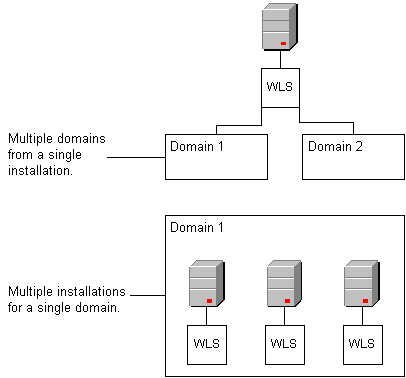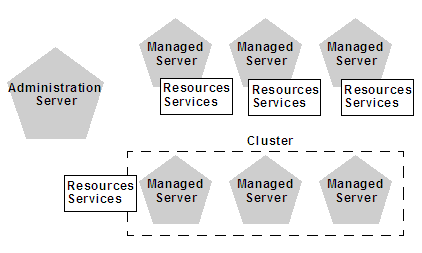4 WebLogic Server Domains
A WebLogic Server domain is a logically related group of WebLogic Server instances, and the resources running on and connected to them, that can be managed as a single administrative unit.
This chapter includes the following topics:
Understanding Domains
The core of a WebLogic domain consists of the Administration Server, which is the central point from which you configure and manage all resources in the domain.
Usually, you configure a domain to include additional WebLogic Server instances called Managed Servers. You deploy web applications, EJBs, web services, and other resources onto the Managed Servers and use the Administration Server for configuration and management purposes only.
Organizing Domains
A WebLogic domain is distinct from a WebLogic Server installation. You create and run multiple domains using a single WebLogic Server installation, or you can create a single domain that encompasses multiple installations. How you organize your domains is based on your needs.
Figure 4-1 shows the relationship between a WebLogic Server installation and a WebLogic domain.
Figure 4-1 Oracle WebLogic Server Installations and Domains

Description of "Figure 4-1 Oracle WebLogic Server Installations and Domains"
How you organize your Oracle WebLogic Server installations into domains depends on your business needs. You can define multiple domains based on different system administrators' responsibilities, application boundaries, or geographical locations of the machines on which servers run. Conversely, you might decide to use a single domain to centralize all Oracle WebLogic Server administration activities.
Depending on your particular business needs and system administration practices, you might decide to organize your domains based on criteria such as:
-
Logical divisions of applications. For example, you might have one domain devoted to end-user functions such as shopping carts and another domain devoted to back-end accounting applications.
-
Physical location. You might establish separate domains for different locations or branches of your business. Each physical location requires its own Oracle WebLogic Server installation.
-
Size. You might find that domains organized in small units can be managed more efficiently, perhaps by different system administrators. Contrarily, you might find that maintaining a single domain or a small number of domains makes it easier to maintain a consistent configuration.
You can create a simple domain that consists of a single server instance. This single instance acts as an Administration Server and hosts the applications that you are developing. Although a single server domain is typically used for development and test environments, this domain type is fully supported for production use and may be appropriate for light-load applications. The wl_server domain that you can install with Oracle WebLogic Server is an example of this type of domain.
Contents of a Domain
Although the scope and purpose of a domain can vary significantly, most Oracle WebLogic Server domains contain the components described in this section.
The following topics describe the primary components of a domain, which may optionally include Managed Coherence servers and Coherence clusters:
Administration Server
The Administration Server operates as the central control entity for the configuration of the entire domain. It maintains the domain's configuration documents and distributes changes in the configuration documents to Managed Servers. You can also use the Administration Server as a central location from which to monitor all resources in a domain.
To interact with the Administration Server, you can use any of the administration tools listed in Summary of System Administration Tools and APIs. See System Administration for information about modifying the domain's configuration.
Each Oracle WebLogic Server domain must have one server instance that acts as the Administration Server.
For more information about the Administration Server and its role in the Oracle WebLogic Server JMX management system, see System Administration.
Managed Servers and Managed Server Clusters
Managed Servers host business applications, application components, web services, and their associated resources. To optimize performance, Managed Servers maintain a read-only copy of the domain's configuration document. When a Managed Server starts up, it connects to the domain's Administration Server to synchronize its configuration document with the document that the Administration Server maintains.
For production environments that require increased application performance, throughput, or high availability, you can configure two or more Managed Servers to operate as a cluster. A cluster is a collection of multiple Oracle WebLogic Server instances running simultaneously and working together to provide increased scalability and reliability. In a cluster, most resources and services are deployed identically to each Managed Server (as opposed to a single Managed Server), enabling failover and load balancing. A single domain can contain multiple Oracle WebLogic Server clusters, as well as multiple Managed Servers that are not configured as clusters. The key difference between clustered and non-clustered Managed Servers is support for failover and load balancing. These features are available only in a cluster of Managed Servers. For more information about the benefits and capabilities of an Oracle WebLogic Server cluster, see Understanding WebLogic Server Clustering in Administering Clusters for Oracle WebLogic Server.
Managed Coherence Servers and Coherence Clusters
Managed Coherence Servers provide in-memory distributed caching for applications. A Managed Server that is configured to be a Coherence cluster member is a Managed Coherence Server. Coherence is integrated within WebLogic server as a container subsystem. The use of a container aligns the lifecycle of a Coherence member with the lifecycle of a Managed Server: starting or stopping a server JVM starts and stops a Coherence cluster member.
A domain can contain a single Coherence cluster that can be associated with Multiple WebLogic Server clusters. Managed Coherence servers that are part of a WebLogic Server cluster inherit their Coherence settings from the WebLogic Server cluster. WebLogic Server clusters are typically used to setup Coherence tiers that organize Managed Coherence servers based on their role in the Coherence cluster.
For details on configuring and managing Coherence clusters, see Administering Clusters for Oracle WebLogic Server.
Resources and Services
In addition to the Administration Server and Managed Servers, a domain also contains the resources and services that Managed Servers and deployed applications require.
Managed Servers can use the following resources:
-
Machine definitions that identify a particular, physical piece of hardware. A machine definition is used to associate a computer with the Managed Servers it hosts. This information is used by Node Manager in restarting a failed Managed Server, and by a clustered Managed Server in selecting the best location for storing replicated session data. For more information about Node Manager, see Node Manager Overview in the Administering Node Manager for Oracle WebLogic Server.
-
Network channels that define default ports, protocols, and protocol settings that a Managed Server uses to communicate with clients. After creating a network channel, you can assign it to any number of Managed Servers and clusters in the domain. See Configuring Network Resources in Administering Server Environments for Oracle WebLogic Server.
-
Virtual hosting, which defines a set of host names to which Oracle WebLogic Server instances (servers) or clusters respond. When you use virtual hosting, you use DNS to specify one or more host names that map to the IP address of a server or cluster. You also specify which web applications are served by each virtual host.
Applications can use the following resources and services:
-
Security providers, which are modular components that handle specific aspects of security, such as authentication and authorization.
-
Resource adapters, which are system libraries specific to Enterprise Information Systems (EIS) and provide connectivity to an EIS.
-
Diagnostics and monitoring services.
-
JDBC data sources, which enable applications to connect to databases.
-
Mail sessions.
-
XML entity caches and registry of XML parsers and transformer factories.
-
Messaging services such as JMS servers and store-and-forward services.
-
Persistent store, which is a physical repository for storing data, such as persistent JMS messages. It can be either a JDBC-accessible database or a disk-based file.
-
Startup classes, which are Java programs that you create to provide custom, system-wide services for your applications.
-
Work Managers, which determine how an application prioritizes the execution of its work based on rules you define and by monitoring actual run-time performance. You can create Work Mangers for entire Oracle WebLogic Server domains or for specific application components.
-
Work Contexts, which enable applications to pass properties to a remote context without including the properties in a remote call.
Roadmap for Understanding WebLogic Server Domains
The WebLogic Server documentation set includes several introductory, procedural, and reference topics, including examples, that help you understand how to create, configure, and manage WebLogic domains.
Table 4-1 Roadmap for Understanding WebLogic Server Domains
| Major Task | Subtasks and Additional Information |
|---|---|
|
Learning more about WebLogic Server domains |
|
|
Creating domains |
|
|
Configuring domains |
|
|
Working with domain templates |
|
|
Examples |
|
|
Reference |
